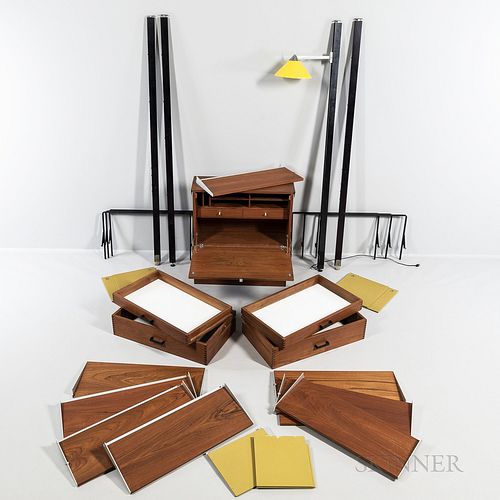George Nelson (1908-1986) for Herman Miller Comprehensive Storage System (CSS) Wall Furniture, Zeeland, Michigan, c. 1972, walnut and m
Lot 1204
About Seller
Bonhams Skinner
274 Cedar Hill Street
Marlborough, MA 01752
United States
Founded over four decades ago, Bonhams Skinner offers more than 60 auctions annually. Bonhams Skinner auctions reach an international audience and showcase the unique, rare, and beautiful in dozens of categories, including the fine and decorative arts, jewelry, modern design, musical instruments, sc...Read more
About Auction
Catalog Only
By Bonhams Skinner
Dec 8, 2020 - Dec 17, 2020
Set Reminder
2020-12-08 12:00:00
2020-12-17 19:00:00
America/New_York
Bidsquare
Bidsquare : 20th Century Design
https://www.bidsquare.com/auctions/skinner/20th-century-design-6191
Our December sale offers over 500 lots for the discerning collector, dealer, or homeowner seeking furniture, artwork, and decorative objects spanning the 20th and early 21st centuries. Bonhams Skinner bidsquare@bonhamsskinner.com
Our December sale offers over 500 lots for the discerning collector, dealer, or homeowner seeking furniture, artwork, and decorative objects spanning the 20th and early 21st centuries. Bonhams Skinner bidsquare@bonhamsskinner.com
- Lot Description
George Nelson (1908-1986) for Herman Miller Comprehensive Storage System (CSS) Wall Furniture, Zeeland, Michigan, c. 1972, walnut and metal, five-bay wall unit consisting of a drop-front desk with storage cubicles and two drawers (20 x 30 3/4 x 13), six drawers (two - 3 1/2 x 30 3/4 x 18; four - 7 1/4 x 30 3/4 x 18) and brackets, four shelves (two - 3/4 x 32 x 18 1/2; two - 3/4 x 32 x 12), two compartment tops and two compartment bottoms (3/4 x 32 x 12 3/4), four sliding doors (1/8 x 15 3/4 x 14 1/2), four adjustable ht. poles (80-84), one with original conical shade lamp (11 1/4 in.), and an original installation manual.
Note: Nelson was an American industrial designer. While lead designer for the Herman Miller furniture company, Nelson and his design studio, George Nelson Associates, designed 20th-century modernist furniture. He is considered a founder of American modernist design.
In 1945, the Herman Miller furniture company was producing mostly conventional, wood-based designs. After reading Tomorrow's House D.J. Depree, the Chairman of Herman Miller, selected Nelson to be the company's next Director of Design, despite Nelson having no experience designing furniture. Depree was more interested in Nelson's insight into the best way to make furniture innovative and useful. Nelson was offered a contract that allowed him the freedom to work outside of Herman Miller, and to use designs from other architects that Nelson had worked with. He became the Director of Design for Herman Miller in 1947, and held the position until 1972. The first Herman Miller catalog produced by Nelson was released in 1945. Over the following years it would include some of the most iconic home furnishings of the 20th century. Ray and Charles Eames, Harry Bertoia, Richard Schultz, Donald Knorr, and Isamu Noguchi all worked for Herman Miller, under Nelson's supervision.Condition
Any condition statement is given as a courtesy to a client, is only an opinion and should not be treated as a statement of fact. Skinner Inc. shall have no responsibility for any error or omission. The absence of a condition statement does not imply that the lot is in perfect condition or completely free from wear and tear, imperfections or the effects of aging. - Shipping Info
-
Please visit http://www.skinnerinc.com/services/payment-and-shipping/ for information regarding the collection of items purchased at auction.
-
- Buyer's Premium



 EUR
EUR CAD
CAD AUD
AUD GBP
GBP MXN
MXN HKD
HKD CNY
CNY MYR
MYR SEK
SEK SGD
SGD CHF
CHF THB
THB














